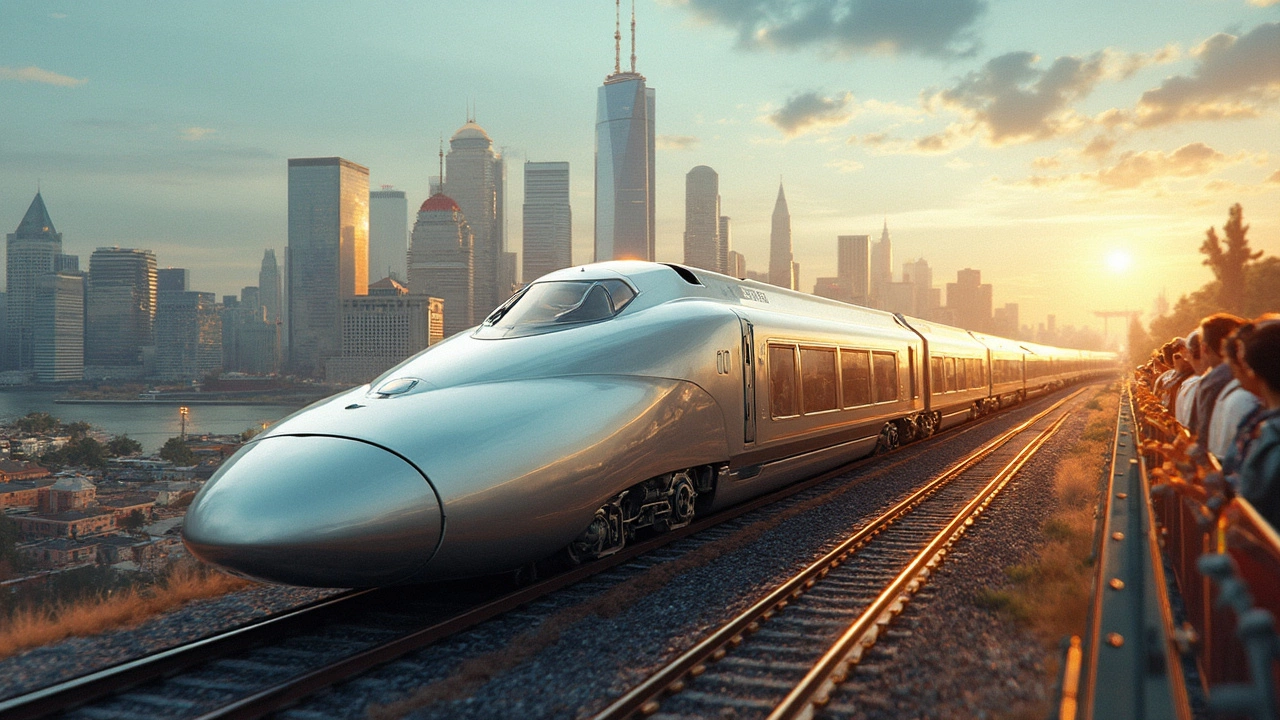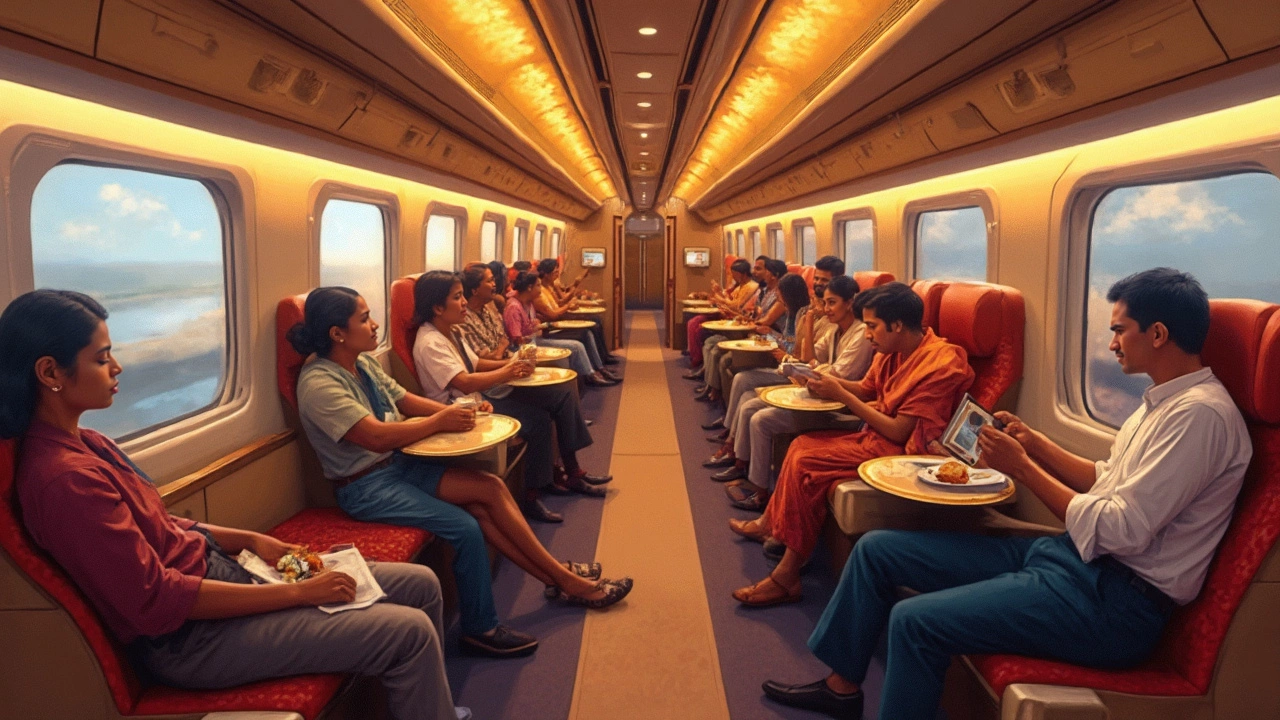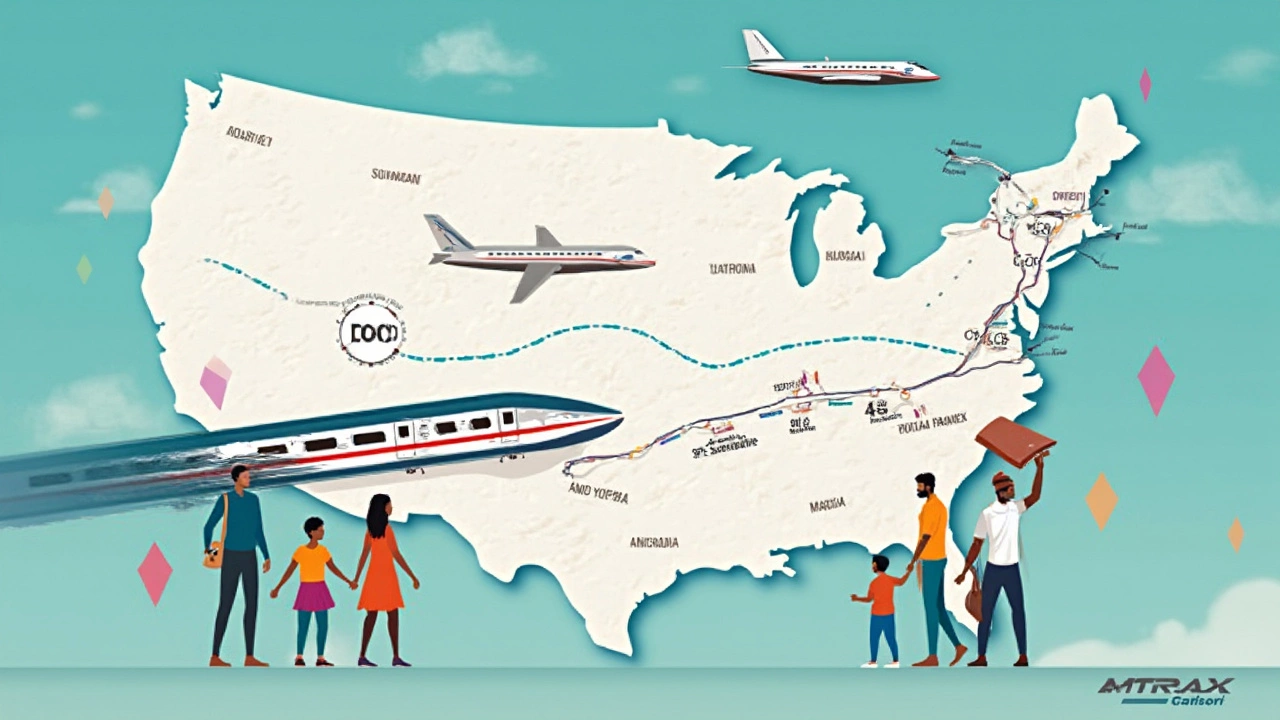Bullet Train from New York to California: How Fast Would the Ride Really Be?
 May, 1 2025
May, 1 2025
If you could hop on a bullet train in New York and ride all the way to California, just about everyone would want to know one thing first: How long would it actually take? The U.S. is crazy wide—over 2,800 miles from coast to coast. Amtrak takes days to do it. Planes can do it in under six hours, but you’re crammed in coach with spotty Wi-Fi and mini pretzels.
Now, picture slicing through the country at over 200 miles per hour. Japan’s Shinkansen and France’s TGV already clock those speeds every day, making the dream of crossing the U.S. at bullet-train pace not so far-fetched. A direct line built for top speed could change the whole vibe of cross-country travel. Some rail experts estimate a high-speed journey from New York to LA could be done in just 12 to 15 hours, with fewer stops than a commercial flight, plus roomier seats and full-on dining cars.
It sounds wild, but there’s real talk behind it. China’s newest bullet trains hit 220 mph and have gone even faster in some tests. If we had tracks as smooth and direct as theirs, you could board after breakfast in Manhattan and see the Pacific sunset before midnight. You’ve gotta wonder what that would do for vacation trips, business deals, and coast-to-coast family visits.
- How Fast Are Bullet Trains, Really?
- Comparing Routes: Train, Plane, and Car
- What Would the Journey Be Like?
- The Real Timeline: Coast-to-Coast in Hours?
- Tips for Making the Most of a Luxury Bullet Train Trip
How Fast Are Bullet Trains, Really?
The word “bullet train” isn’t just marketing hype. In countries like Japan, China, and France, high-speed trains have been zipping along at speeds that regular trains can only dream about. Japan’s Shinkansen tops out at 200 mph (320 km/h) on some routes. China’s Fuxing Hao trains hit a wild 220 mph (350 km/h) on a regular basis. And the French TGV? It once hit 357 mph (574 km/h) in a special test, though its usual speed is closer to 200 mph for passengers.
Speed records sound cool, but what about real-world trips? Here’s where things get interesting. The average bullet train service doesn’t run at absolute max speed the whole time, because of curves, stations, and safety. Still, these trains shrink countries. For example, a ride from Tokyo to Osaka (about 320 miles) takes just 2.5 hours on the Shinkansen. In California, getting from San Francisco to LA by car can easily swallow up six to seven hours—if you’re lucky with traffic.
| Country | Fastest Commercial Speed (mph) | Famous Train Model |
|---|---|---|
| Japan | 200 | Shinkansen |
| China | 220 | Fuxing Hao |
| France | 200 | TGV |
| Italy | 190 | Frecciarossa |
For a little perspective, the best Amtrak can do right now is around 150 mph, and that’s just on small stretches in the Northeast. Most of the U.S. rail system is far slower.
As for benefits, there’s more than just speed. Luxury train rides are smoother, quieter, and roomier than what passes for fast travel in the States right now. According to the International Union of Railways:
“High-speed trains dramatically reduce journey times while providing a comfortable travel experience, even over long distances.”
So, if you’re imagining rolling across America on a high-speed rail at 200+ mph, you’re not dreaming. The options already exist elsewhere, and the numbers prove it could work here, too.
Comparing Routes: Train, Plane, and Car
Let’s line up the options for getting from New York to California. Each has its own mood, time kick, and comfort level. Here’s how they stack up:
- Car: You’re looking at 2,800 miles minimum. Most folks need four or five days of hard driving—figure 40+ hours behind the wheel, not counting rest stops, food breaks, or traffic jams. Gas, hotels, food, and fatigue add up fast. It’s all about the road trip vibe, not speed.
- Current Train (Amtrak): Amtrak’s "Lake Shore Limited" and "California Zephyr" combo is the closest you get. The trip usually takes three to four days with stops. Delays aren’t rare. Think sleeping cars, old-school dining, and a slow, scenic crawl through the Rockies and Midwest. Nice if you want to unplug, but not for anyone in a hurry.
- Plane: The coast-to-coast travel time shrinks to 5.5 or 6 hours on a direct flight. Add about two hours for airport ordeal on both ends and you’re at 10-12 hours door to door. Comfort varies—first class is dreamy, but most are squished in coach. It’s fast, but definitely not luxurious.
If a bullet train ever links New York and California, most models say it could do the trip in 12 to 15 hours. That’s the sweet spot—cutting travel time to half a regular train, and about matching the full airport-included plane experience. But the big perk? Way more space, no TSA lines, and true comfort all the way.
| Mode | Time (Door-to-Door) | Comfort | Average Cost |
|---|---|---|---|
| Car | 40+ hours | Low (unless you love road trips) | $600-$1,000+ (gas, hotels, food) |
| Amtrak | 72-96 hours | Medium (with sleeper) | $300-$1,000 (depending on class) |
| Plane | 10-12 hours | Low to High | $200-$800 (economy to first class) |
| Bullet Train | 12-15 hours (estimate) | High | Probably similar to premium Amtrak or business class flight |
So if you want the fastest ride and don’t mind airport chaos, plane wins for now. But if you’re hunting for a smoother, roomier, and possibly even scenic trip, the bullet train would be a serious game changer if we ever build it.

What Would the Journey Be Like?
Imagine rolling out of New York’s Penn Station on a bullet train built for speed—200 mph from the get-go. Right away, you’d notice that things look more like flying first class than taking any regular train. Wide seats, plenty of legroom, power outlets at every spot. The windows would be huge, made for snapping up views as you hit streaks of open country and rush past sleepy towns. Forget bouncing around with every bump; high-speed rail rides are way smoother than what Amtrak’s got now.
The dining situation would probably surprise you too. No sad microwave meals like you see on a plane. Japan’s Shinkansen and Europe’s TGV serve up actual chef-cooked food—think rice bowls, pastries, and fresh coffee, right at your seat or in a sleek dining car. The Wi-Fi would be solid (China’s Fuxing trains already have fast internet on board), and there’d be real room to stretch, get work done, or just chill with your phone.
- Travel time: The real upgrade is the time savings. At 220 mph, you could cover about 500 miles in a little over two hours. That’s four times faster than typical Amtrak routes.
- Comfort: Quiet cabins, smooth ride, and space to move around. If you’ve taken Japan’s bullet trains, it’s that same peace but for way longer.
- Views: You’d cross everything: city skylines, forests, long stretches of desert, and snowy mountain passes. Add big panoramic windows, and you just can’t get that on a plane.
If you like numbers, check this out. Here’s a quick comparison of features:
| Experience | Bullet Train | Plane | Amtrak |
|---|---|---|---|
| Seat Space (inches) | 20-22 | 17-18 | 18-20 |
| Wi-Fi | Yes (fast) | Sometimes (spotty) | Often (slow) |
| Dining | Fresh meals | Premade snacks | Microwave options |
| Scenery | Yes, panoramic | Limited, small window | Yes, but slower |
With a trip like this, you don’t just “get there”—you actually enjoy the journey. Whether you’re traveling for work, family, or just to see the country, a New York to California bullet train would totally change the way we think about long-distance travel in the U.S.
The Real Timeline: Coast-to-Coast in Hours?
Right now, taking a regular Amtrak train from New York to California eats up a big chunk of your week—almost four full days, with lots of stops and delays. It’s more of an experience than a quick way to get across the country. So, what would a bullet train do differently?
Let’s get straight to the numbers. The distance from New York City to Los Angeles is about 2,800 miles. The fastest high-speed rail trains running today, like the Shanghai Maglev or France’s TGV, regularly top 200 mph. Some test runs have hit nearly 270 mph. But with stops, curves, and real-life stuff, most systems average closer to 180 mph for long distances.
| Route | Mode | Average Speed (mph) | Travel Time |
|---|---|---|---|
| NYC to LA | Standard Amtrak | ~50 | ~67 hours |
| NYC to LA | Flight | ~500+ | 6 hours |
| NYC to LA | Bullet Train (theory) | 180–220 | 12–15 hours |
Here’s the wild part—if we had tracks as direct and efficient as those in China or Japan, and you grabbed a bullet train running an average of 200 mph, coast-to-coast could take a very doable 14 hours. It’s not as quick as hopping on a plane, but think about the upgrades: no TSA lines, no turbulence, and way more space.
This time frame could be even better with non-stop express services. Cutting back on stops for major cities only could chop off another hour or two. But—realistically—we’d have stops for refueling, fresh crew, or to pick up and drop off passengers in key cities like Chicago or Denver.
- With a bullet train, you could leave New York in the morning and hit LA by late evening—just imagine watching the scenery shift from big city skyscrapers to open plains and finally to palm trees, all within a day.
- It would blow regular train comfort out of the water: no cramped seats, room to walk around, big windows for sightseeing, maybe even Wi-Fi that actually works.
- This isn’t sci-fi—Japan’s newest Shinkansen already makes Tokyo-Osaka (over 300 miles) in less than 2.5 hours. Scale that up, and cross-country high-speed rail is possible with the right investment.
So if you’re hunting for that new breed of luxury train adventure, keep your eyes on high-speed rail projects. When this coast-to-coast dream finally happens, your whole idea of American travel speed is going to change.

Tips for Making the Most of a Luxury Bullet Train Trip
So you’re thinking of jumping on a luxury bullet train from New York to California? This is nothing like a regular train ride. With the speed, comfort, and extras, you want to get every bit of experience you can for your money. Here’s how to get it right.
- Book a Suite or Premium Car: The top-level cabins give you way more space than coach and usually include beds, private bathrooms, and bigger windows. Some trains in Europe and Asia even offer dedicated butler service for high-end seats. Expect American versions to copy that, too.
- Pick Your Route and Stops: If there’s an option, look for a route that hugs the best views, like the Rockies or Californian coast. Stopping at fewer major cities also means you’ll spend less time waiting and more time moving fast.
- Pace Your Meals: Lots of fancy trains offer multi-course dinners with regional dishes. Sign up early for the meal times you want—prime spots fill up fast. And eat light during the day so you can really enjoy the top meals, which are usually dinner or lunch.
- Pack Smart Tech: Bring devices that work offline in case Wi-Fi cuts out in remote areas. Download books, shows, and games ahead of time. Bring a compact power bank; outlets are common, but not always at every seat.
- Don’t Miss the Lounges: On some high-speed lines, your premium ticket gets you access to onboard lounges with better snacks, drinks, and more space to chill.
Here’s a quick rundown of some extras offered on luxury trains around the world, so you can know what to look for when U.S. bullet trains finally arrive:
| Train | Perks | Countries |
|---|---|---|
| JR East Shinkansen Gran Class | Reclining seats, gourmet meals, lounge access | Japan |
| TGV First Class | Extra space, full meals, fast Wi-Fi | France |
| Amtrak Acela First | Priority boarding, plated meals, quiet car | USA (Northeast) |
One more insider tip: Dress for comfort, but bring a light sweater or jacket. Trains sometimes overdo the air conditioning, and you’ll want to feel cozy for hours at a time.
Thinking about snapping photos for the ’gram? Head to the observation car early—window seats fill up, and sunrise or sunset looks even better flying past at bullet train speeds.